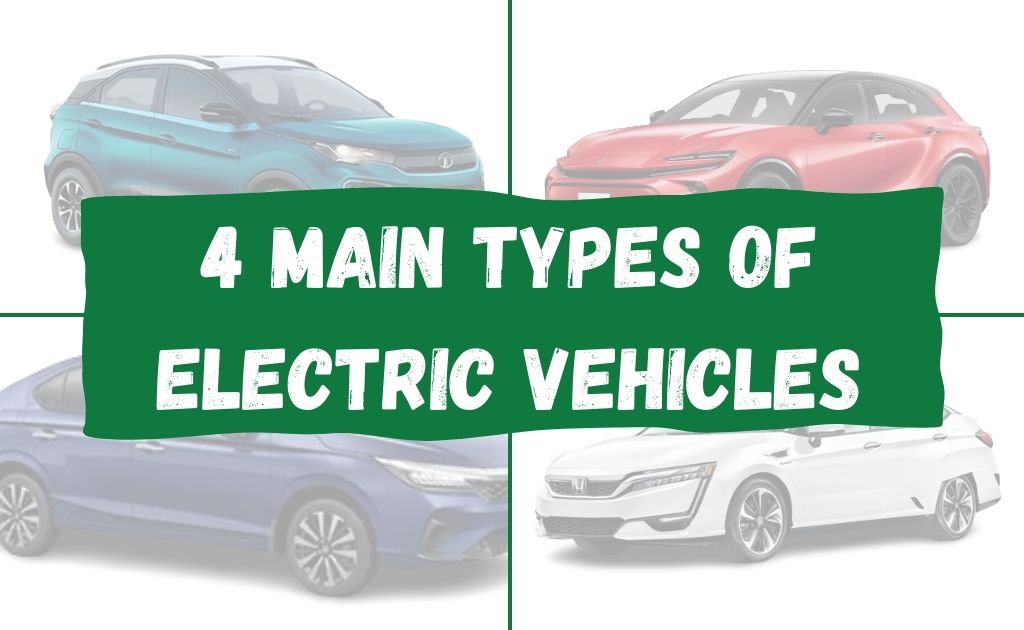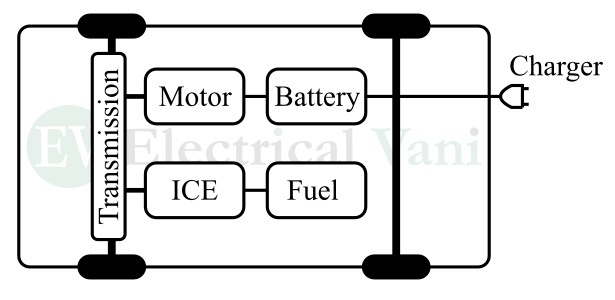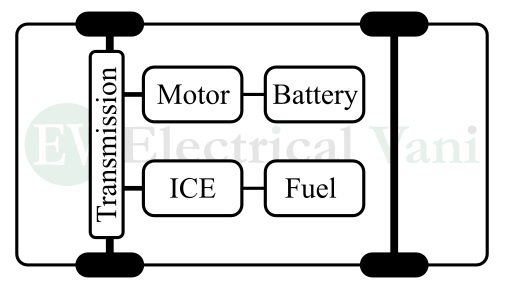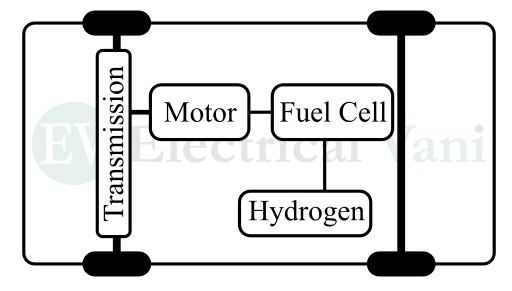In this article, we will explore the basics, advantages, and limitations of 4 main types of electric vehicles. An electric vehicle, also called an EV, is a kind of vehicle that utilizes electrical energy as a source of energy and electric motors as a source of mechanical power required for the propulsion of the vehicle. In an electric vehicle, electrical energy is the primary source of energy like petrol in an internal combustion engine vehicle.

The primary reason behind the development and use is to reduce the consumption of fossil fuels and reduce the environmental impact.
Types of Electric Vehicles
Electric vehicles can be classified into several types depending on their construction, working, advantages, and limitations. The following four are the main types of electric vehicles:
- Battery Electric Vehicles (BEVs)
- Plug-in Hybrid Electric Vehicles (PHEVs)
- Hybrid Electric Vehicles (HEVs)
- Fuel Cell Electric Vehicles (FCEVs)
Let’s discuss each type of electric vehicle in detail along with their features, advantages, and limitations.
(1). Battery Electric Vehicles (BEVs)
A type of electric vehicle that is powered only by electric batteries and does not use an internal combustion engine to develop the propulsion power is called a battery electric vehicle (BEV).
Thus, in a battery electric vehicle, the only source of energy is high-capacity batteries. In other words, the operation of battery electric vehicles is entirely dependent on the electricity stored in batteries.

Main Components of BEVs
There are main components of a typical battery electric vehicle are described below:
- Electric Motor – It is the engine of a battery electric vehicle as it produces the propulsion power and drives the wheels of the vehicle.
- Battery Pack – It is used to store the electrical energy required to power electric vehicles. The battery capacity determines the range of the battery electric vehicle.
- Auxiliary Battery – It is usually a 12 V or 24 V battery used to power auxiliary systems like lights, windows, air conditioner, etc. of the vehicle. It is charged by tapping the electric power at a lower voltage from the main battery pack.
- Onboard Charger – This is a device used to recharge the batteries from a source of external power. It contains a rectifier circuit that converts the AC power from the electric grid to DC power for battery charging.
- Inverter – It is an electronic circuit that converts the DC electricity of a battery into AC electricity required to operate electric motors.
- Regenerative Braking System – It is one of the important components of a battery electric vehicle. It is a system that captures the energy lost during the braking of a vehicle converts it back into electricity and stores it in the battery pack. This system is responsible for enhancing the BEV’s performance and increasing the range.
- Controller – It is the brain of a battery electric vehicle. It monitors and controls the overall operation of the electronic system of the battery electric vehicle.
Advantages of BEVs
Battery electric vehicles offer numerous benefits over other types of electric vehicles. The following are some key benefits of battery-electric vehicles:
- Battery electric vehicles do not emit air pollutants like oxides of nitrogen and sulfur while running. Hence, they help reduce air pollution and greenhouse emissions.
- The charging stations of battery electric vehicles are generally based on renewable energy like wind and solar. Hence, they reduce carbon footprint significantly.
- Battery electric vehicles provide a lower cost per km or mile i.e., low operating cost.
- Due to the use of fewer mechanically moving parts, battery electric vehicles require less maintenance and hence less maintenance cost.
- Battery electric vehicles are more energy efficient than other types of vehicles due to the use of electric motors and regenerative braking systems.
- Battery electric vehicles have quiet operation and quick acceleration.
Limitations of BEVs
Although battery electric vehicles have several advantages. But they also have some limitations and problems associated with them. The following are some key limitations and disadvantages of battery-electric vehicles:
- Battery electric vehicles provide a shorter range on a single charge as compared to a traditional petrol-based vehicle.
- The charging infrastructure for battery electric vehicles is still under development.
- Battery electric vehicles require a longer time to fully charge.
- Batteries used in battery electric vehicles degrade over time affecting their performance and driving range.
- Battery electric vehicles are relatively expensive to purchase.
- Battery electric vehicles are available in limited models and variants in the market.
(2). Plug-In Hybrid Electric Vehicles (PHEVs)
The type of electric vehicle in which both internal combustion engine and electric motors are used to propel the vehicle is called a plug-in hybrid electric vehicle (PHEV).
The plug-in hybrid electric vehicles are charged by plugging into an external source of electricity.
Hence, a PHEV utilizes a dual source of power i.e., an internal combustion engine and an electric motor.

Main Components of PHEVs
The following are the main components of the plug-in hybrid electric vehicle:
- Internal Combustion Engine – It is a device that runs on petrol or diesel and produces propulsion power.
- Electric Motor – It converts electrical energy into mechanical energy and propels the vehicle when it operates in electric mode.
- Battery Pack – The plug-in hybrid electric vehicle has a rechargeable battery pack that can be recharged from an external source of electricity and power the electric motor.
- Fuel Tank – It is a container used to store petrol or diesel and supply fuel to the internal combustion engine.
- Exhaust System – It is a device used to expel the combustion gases from the internal combustion engine.
- Onboard Charger – It is a device used to convert AC electricity from the grid to DC electricity to recharge the battery pack.
Hence, a plug-in hybrid electric vehicle combines the ICE and electric vehicle technologies to provide an efficient blend of transportation.
Advantages of PHEVs
The following are the major benefits of plug-in hybrid electric vehicles:
- The plug-in hybrid electric vehicle combines the benefits of both electric and fuel-powered vehicle technologies.
- The plug-in hybrid electric vehicle provides an economical electric mode for shorter driving ranges while the gasoline mode is for extended trips.
- Plug-in hybrid electric vehicle reduces fuel consumption through electric mode operation and reduces the operational cost.
- Plug-in hybrid electric vehicle reduces the zero tailpipe emissions and air pollution.
- Plug-in hybrid electric vehicle reduces the dependence on only fossil fuels and only electricity.
Limitations of PHEVs
The key limitations and disadvantages of plug-in hybrid electric vehicles are listed below:
- The plug-in hybrid electric vehicle provides a limited range in electric-only mode. Hence, in electric-only mode, they are suitable for short trips only.
- Plug-in hybrid electric vehicles are dependent on charging infrastructure to recharge the battery pack.
- Plug-in hybrid electric vehicles take a longer time to fully recharge the battery pack.
- The dual power source i.e., internal combustion engine and electric motors increases the complexity and weight of the vehicle.
- Plug-in hybrid electric vehicles operate like traditional gasoline-powered vehicles on longer trips.
- The maintenance of plug-in hybrid electric vehicles requires both expertise and higher cost.
- The initial cost of plug-in hybrid electric vehicles is higher than traditional vehicles.
This is all about plug-in hybrid electric vehicles.
(3). Hybrid Electric Vehicles (HEVs)
A hybrid electric vehicle (HEV) is a type of vehicle that combines both internal combustion engine and electric motors to propel the vehicle. But it does not use a plug-in charger to recharge the electric batteries. Instead, the batteries are recharged through regenerative braking and extra power produced by the combustion engine.
Hence, hybrid electric vehicles do not require any external charging infrastructure.
The combined use of ICE and electric propulsion systems improves fuel efficiency and reduces emissions.
Basically, hybrid electric vehicles are the middle ground between ICE vehicles and battery electric vehicles.

Advantages of HEVs
The following are the major benefits of hybrid electric vehicles:
- Hybrid electric vehicles provide enhanced fuel efficiency.
- Hybrid electric vehicles significantly reduce the emission of air pollutants and carbon footprint.
- Hybrid electric vehicles have an automatic start and stop system to switch between the ICE mode and electric mode.
- Hybrid electric vehicles do not require an external source of energy to recharge the battery, instead, they use regenerative braking and engine’s power.
- Hybrid electric vehicles are a better option for frequent stop-and-start driving conditions like in a congested city.
- Hybrid electric vehicles provide an extended driving range as compared to battery electric vehicles.
- The operating cost of a hybrid electric vehicle is lower than a traditional electric vehicle.
Limitations of HEVs
Hybrid electric vehicles offer several advantages over fully electric vehicles and internal combustion engine electric vehicles. But they also have some limitations which are given below:
- Hybrid electric vehicles provide a shorter driving range in electric-only mode of operation.
- Hybrid electric vehicles use smaller and less powerful batteries than other types of electric vehicles. This significantly impacts their overall performance and efficiency.
- Hybrid electric vehicles combine two different technologies i.e., internal combustion engine and electric vehicle. This leads to the complexity of the powertrain and higher design and manufacturing costs.
- Hybrid electric vehicles are relatively expensive to purchase.
- Hybrid electric vehicles are heavier due to additional components like battery packs, electric motors, etc.
Hence, this is all about the basics of hybrid electric vehicles, their advantages and disadvantages.
(4). Fuel Cell Electric Vehicles (FCEVs)
A type of electric vehicle in which fuel cells are used to produce electricity to power the electric motors is called a fuel cell electric vehicle (FCEV).
In fuel-cell electric vehicles, hydrogen gas is used as the primary fuel to produce electrical energy. In a fuel cell, the electrical energy is generated through the reaction between hydrogen and oxygen. Then, this electrical energy is utilized to power an electric motor that in turn propels the vehicle.
The byproduct of the chemical reaction between hydrogen and oxygen is water vapor which makes the fuel cell electric vehicles clean and eco-friendly. Hence, the fuel-cell electric vehicles are also known as zero-emission vehicles.

Main Components of FCEVs
A fuel cell electric vehicle is a complex system having a large number of components to convert the energy of hydrogen fuel into electrical energy that is then utilized to operate the electric motors. Here are the main components of a fuel-cell electric vehicle:
- Fuel Cell Stack – It is the fundamental component of a fuel cell electric vehicle. It is the device in which an electrochemical reaction takes place between hydrogen fuel and oxygen. A single fuel cell stack consists of multiple fuel cells to produce electricity and water vapor.
- Hydrogen Fuel Tank – It is a container used to store hydrogen gas at high pressure. It is usually made of carbon fiber to provide high strength and safety.
- Electric Motor – It is used to convert electrical energy into mechanical energy and rotate the wheels of the vehicle.
- Auxiliary Battery or Supercapacitor – A small battery or supercapacitor is used to store extra electricity generated by the fuel cell. It also stores electricity generated through regenerative braking. This electricity is then utilized during peak demand.
- Controller – It is an electronic system that monitors and regulates the flow of electricity from the fuel cell to the electric motor. It ensures the smooth operation of the vehicle.
- Exhaust System – In fuel cell electric vehicles, an exhaust system is employed to release the water vapors from the fuel cell.
Advantages of FCEVs
The main advantages of fuel-cell electric vehicles are listed below:
- Fuel cell electric vehicles are zero-emission electric vehicles that do not produce any harmful tailpipe emissions.
- Fuel cell electric vehicles have very high energy efficiency as compared to other types of electric vehicles. This is because they directly convert the chemical energy of hydrogen fuel into electricity.
- Fuel-cell electric vehicles can provide a longer driving range.
- The refueling time of a fuel cell electric vehicle is small and it is almost equal to the petrol vehicle.
- Fuel cell electric vehicles have high power density which makes them suitable for heavy vehicles like trucks and buses.
- Fuel cell electric vehicles have a quieter operation than ICE vehicles.
Thus, all these are the key advantages of fuel-cell electric vehicles. Let us now talk about their limitations.
Limitations of FCEVs
Fuel cell electric vehicles have several advantages, but they also have some limitations and disadvantages. Some key limitations of fuel-cell electric vehicles are listed below:
- Limited hydrogen fuel infrastructure, as the hydrogen fuel stations are expensive to establish and operate.
- Fuel cell technology is quite expensive.
- There are safety issues in hydrogen storage and it requires heavy and expensive storage tanks.
- The overall efficiency of converting hydrogen into electricity is low.
- Hydrogen fuel is relatively expensive and not readily available to consumers.
- The upfront cost of a fuel cell electric vehicle is higher than a battery or ICE vehicle.
Hence, this is all about the basics, advantages, and limitations of fuel-cell electric vehicles.
Conclusion
In conclusion, an electric vehicle is a type of vehicle that utilizes electricity and electric motors for propulsion. Electric vehicles can be broadly classified into four classes namely, battery electric vehicles, plug-in hybrid electric vehicles, hybrid electric vehicles, and fuel cell electric vehicles. All these electric vehicles have their own benefits and limitations. In this detailed article on “types of electric vehicles”, we have discussed the basics, main components, advantages, and limitations of all these 4 main types of electric vehicles.
Hello! Someone in my Facebook group shared this website with us so
I came to give it a look. I’m definitely loving the information. I’m bookmarking and will be tweeting this to
my followers! Superb blog and outstanding design and style.
Thankyou 🙂 Christy Mcpeak